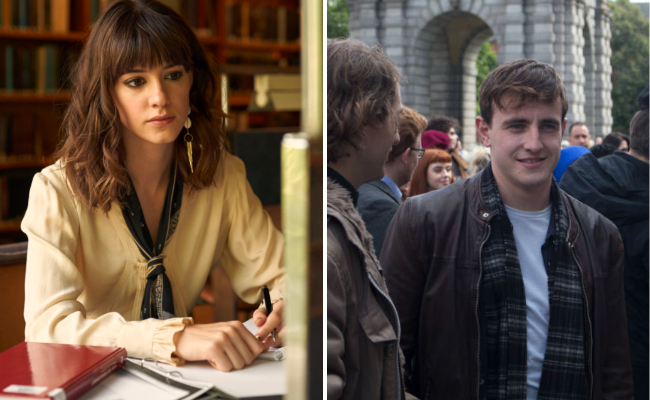
The television adaptation of Sally Rooney’s bestselling novel Normal People undoubtedly captured the attention of the world earlier this year with its tender, excruciating story of Connell and Marianne, played by the inimitable Paul Mescal and Daisy Edgar-Jones.
We see these two navigate their friendship and romantic relationships as they finish school in Sligo, and move to Dublin to attend Trinity. It is difficult to choose one aspect of the story to use as the series’ descriptor. Is it a love story? A tale of the changes we undergo between school and college? A depiction of mental health for young people in Ireland? It is all of these things and more, and despite not being a story about fashion, the clothing in Normal People tones beautifully with the script, direction, and acting to create a heart-rending and gorgeous series.
The show’s costume designer Lorna Marie Mugan, who has also worked on popular series like Peaky Blinders, says her aim was to “enhance” the story’s characters – to make them more relatable and tangible.
Normal People is a story very specific to place and how people can thrive or suffer in different spaces. Mugan’s work is thoughtful, and her costume choices stemmed from an empathetic grasp of each character’s situation. She believes that Connell is “the one that feels more disconnected at Trinity … whereas for Marianne it’s a place to blossom”. Being set in Trinity, it was important to capture an authentic sense of the students’ style, so Mugan and her team spent a lot of time on campus, taking photographs and “befriending people through Instagram”.
Connell is not going to suddenly wear chinos and slip on shoes at Trinity
Much like finding your own personal look, it was a lengthy process to find the right wardrobe for each character. “It’s a trial and error process, but you start with some ideas and just hash it out. And be prepared to let things go that sounded great and looked great on a storyboard.” Mugan’s aim was to visually communicate the personal growth or experimentation one sees when settling in to college, as clothing is the most visible reflection of these changes. She wanted to convey the “little shifts along the way, when things happen and relationships fall apart and new relationships start” – those little moments that form a person’s identity.
We see this particularly clearly in Marianne’s sartorial evolution from awkwardly choppy bangs, school uniforms and one foray into the tricky world of synthetic bodycon dresses in Sligo, to vintage blouses and blazers in silk and velvet at Trinity. The change in Marianne’s way of dressing tracks with her blossoming in college, though we still see her in certain jumpers from her school days that add a subtle note of realism. Mugan’s favourite outfit of Marianne’s is the 1930s silk blouse and pair of silk culottes that she wears when we first see her in Trinity, merrily drinking and smoking outside a party in the Rubrics: “The real Marianne is the one you see at Trinity.”
To source the clothing, Mugan mainly looked to the vintage and charity shops of Dublin. With velvet jackets from the Harlequin, blouses from NCBI in Rathmines, dresses from Jenny Vander, and so on, the list of sources for Marianne’s iconic looks reads like a well-trodden route of sustainable shopping crawls run by many a Trinity society. “That was the plan”, Mugan agrees. “We want them to look like students … and that’s where people shop.”
Connell’s costumes, though “less glamourous in the world’s eyes”, reflect the character’s journey in just as thoughtful a way as Marianne’s. “He’s less inclined to change”, Mugan explains. “I wouldn’t say he’s very sure of himself, but his identity is much more rooted in his home. So the sports look, the GAA, all that is really important to him. He’s not going to suddenly wear chinos and slip on shoes at Trinity, nor is he going to become really funky and all that.”
We want them to look like students … and that’s where people shop
Entertaining the idea of Connell rocking up to lectures in the Arts Block wearing rolled up jeans and dad trainers, a rollie tucked behind his ear and a 1980s print jumper on his back, is amusing – if not slightly alarming. Thankfully, Mugan’s subtle touch sees Connell’s style change gradually. “He’s pretty much wearing the same kind of look until maybe a bit later, when Helen comes in. I just imagine she’s buying him a jumper, so he’s got a few different little things and he might have bought himself a leather jacket.”
The mention of Connell’s now-famous chain prompts a laugh from Mugan, who couldn’t have predicted the reaction to that particular piece. “You don’t know what is going to capture the interests and the imagination of the public”, she says, but points out that the filming of the show was “very intimate”, with a lot of close shots that frame the main characters’ faces, making the chain as prominent a sight as Paul Mescal’s face.
His GAA shorts also have warranted a slew of articles and tweets from the likes of GQ, which is promoting the “short shorts” as this summer’s big trend. Internet users have also pointed out a pair of Gucci GAA-esque shorts that cost €550 – a move that prompted sportswear company O’Neills to tweet, in perhaps the most surreal piece of fashion news to come out of lockdown, “only 102 years ahead of ye lads @gucci, we’ve been keeping Ireland stylish since 1918”.
The response to the show from audiences around the world no doubt was intensified thanks to the timing of its release. Separated from Trinity campus, college friends and “normal” life, watching Normal People was an odd exercise of catharsis and of appreciation for a beautiful piece of storytelling. The empathy, intimacy and complicated normality of the story are expressed excellently, and the clothes are certainly integral to that.






